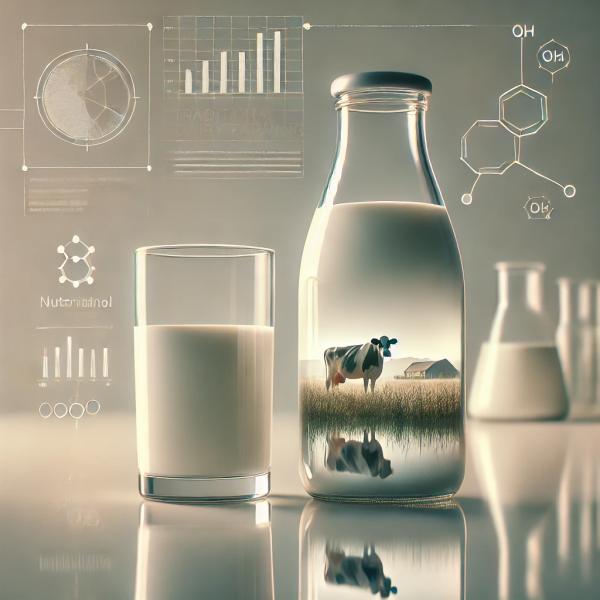
Many health influencers and integrative doctors have decided to demonize milk, creating a parallel reality that could rival the imagination of any sci-fi screenwriter. For those wondering, milk is generally healthy but not recommended for individuals who are lactose intolerant or allergic to milk proteins. Full-fat milk contains a relatively high amount of saturated fats, which are linked to poorer cardiovascular outcomes; some arguing it's better to consume full-fat milk in moderation compared to semi-skimmed or skimmed versions.
The dystopian narrative of influencers and integrative medicine, which has gained traction on social media platforms, includes assertions that raw milk is healthier than pasteurized milk and that A1 casein in milk causes health issues such as cognitive decline, allergies, and even cancer.
The rhetoric of these "dairy terrorists" relies on pseudoscientific jargon, cherry-picking studies, scapegoating a wide range of nonspecific diseases and symptoms, and the naturalistic fallacy – that Mother Nature knows best.
This issue was highlighted in a New York Times article published in July of this year, recounting the story of Jackie’s son, who was hospitalized for three days after contracting salmonella. The infection was traced to raw milk from Raw Farm, a dairy producer in Fresno, California.
Jackie’s son was one of 171 people infected during a salmonella outbreak linked to consuming Raw Farm’s unpasteurized milk between September 2023 and March 2024. Of these cases, 22 required hospitalization, and 40% of those infected were children under five.
Michael Osterholm, director of the Center for Infectious Disease Research and Policy at the University of Minnesota, suggested that the actual number of cases could be higher, as many individuals with foodborne illness symptoms do not seek medical attention or undergo testing.
Despite warnings from health authorities about the risks of raw milk—ranging from mild diarrhea to life-threatening conditions, particularly in children and the elderly—interest in raw milk continues to rise. NielsenIQ reported a 35% increase in raw milk sales in June 2024 compared to the previous year
Milk and the A1/A2 Hypothesis
Cow's milk contains two main protein groups: caseins, which comprise about 80% of the total proteins, and soluble proteins, including enzymes. Caseins are further divided into four types: αs1-caseins, αs2-caseins, β-caseins, and κ-caseins, each with unique functions and structures.
Health influencers often raise concerns about the presence of A1 β-casein, suggesting that milk containing the A2 variant is a safer option. My research indicates this theory was initially proposed by Sir Robert Bartlett Elliot, a New Zealand pediatrician, and Corran McLachlan, a chemical engineer and founder of The a2 Milk Company, which markets A2 milk in various forms.
The book β-Casomorphins: A1 Milk, Milk Peptides, and Human Health, authored by Mohammad Haq, a researcher at India’s National Dairy Research Institute (ICAR), is a key reference for understanding this theory. The general premise is that the digestion of A1 casein produces by-products that may be harmful to health. The purported effects include links to conditions such as diabetes and autism, leading to suggestions that milk containing A2 protein should be preferred.
The hypothesis is supported by observational studies comparing populations consuming different types of milk and animal research. For instance, Haq notes that some population studies have found a strong correlation between A1 β-casein consumption and the incidence of type 1 diabetes (T1D) in children aged 0-14 years. This correlation was not observed when analyzing total milk protein consumption.
While observational studies are valuable, they only establish correlation, not causality. Moreover, confounding variables, other differences between the populations being compared may influence results.
Haq points to animal research, like a study linking A1 β-casein to diabetes in rats, and to consumer reports of bloating, diarrhea, and nausea after consuming A1 milk, which disappear when switching to A2 milk – suggesting that some individuals may be intolerant to BCM-7, a peptide in A1 milk.
This criticism is further elaborated in a recent meta-analysis evaluating studies indexed in the Scopus database, a multidisciplinary index of peer-reviewed research.
Overall, the 119 studies reviewed show conflicting results:
- Some animal experiments suggest that BCM-7 may have anti-inflammatory and generally favorable effects on the body.
- Other studies reported adverse outcomes when assessing the influence of BCM-7 and A1 β-casein on the immune system.
The researchers, while noting those findings, write,
“Stronger scientific evidence is needed to reach a consensus on whether the presence of β-casein A1 can significantly negatively affect health.”
Is milk healthy?
I believe the most robust evidence on milk consumption comes from another meta-analysis published in Nutrition & Metabolism. This umbrella review summarized the benefits and risks of milk consumption across various health outcomes. Their detailed analysis considers 41 studies.
The results were, again, conflicting across various health outcomes. For example, a 200 ml increase in daily milk consumption was found to be associated with a 7% reduction in the risk of stroke, a 6% reduction in the risk of cardiovascular disease, and a 4% reduction in the risk of hypertension. However, consuming 200 g/day of milk was associated with a 3% higher risk of prostate cancer.
Notably:
- Low-fat milk was linked to a reduced risk of colorectal cancer, with each additional serving lowering the risk by 10%.
- Higher milk intake was associated with lower risks of type 2 diabetes, metabolic syndrome, obesity, and Alzheimer's. An increase of 200 g/day reduces metabolic syndrome risk by 13% and obesity risk by 16%.
- In contrast, high milk consumption increased the risk of Parkinson's, with a 17% higher risk for every 200 g/day consumed.
- Cow's milk allergy (an immunological reaction to cow's milk proteins, which can cause symptoms such as irritation and swelling of the face and lips) affects 0.6% to 3.0% of people,
- Lactose intolerance ranges from 0% to 17.9%, although most individuals with lactose intolerance can tolerate 12-15 g of lactose, roughly the amount in a cup of milk.
However, before falling into nutritional epidemiology research’s false dichotomy — where food is simultaneously considered a villain for several health conditions and protective for many others — it is important to discuss some key aspects of the included studies:
- 62.2% of studies showed moderate to high variability (heterogeneity) in treatment, population, and methodology, raising concerns about combined results.
- Only 31.6% of studies reported no publication bias.
- Most studies in the meta-analysis were of low or critically low quality (39.8% and 19.4%), according to AMSTAR-2 [1], mainly lacking disclosure of funding.
- GRADE [2] ratings showed most studies as "low," "very low," or "moderate" quality, with none classified as "high quality" due to bias, inconsistency, and imprecision in the observational studies.
Based on their findings, the authors concluded that milk consumption appears to offer more benefits than harms to human health, suggesting that it should be included as part of a healthy diet.
I believe the authors' conclusion is, within certain limits, correct. While acknowledging that milk can be part of a healthy diet, it is not a magical substance that inherently brings benefits. In most cases, no single food—when consumed in moderation—will play a crucial role in health, for better or worse. Milk fits perfectly within this guidance.
The only individuals who should avoid milk are those who are lactose intolerant, allergic to milk proteins, or simply dislike the taste. You can safely include milk in your diet if you don't fall into one of these categories.
[1] A 16-item checklist designed to assess the methodological quality of systematic reviews that include both randomized and non-randomized studies
[2] A system for rating the quality of evidence in systematic reviews and other evidence syntheses.



